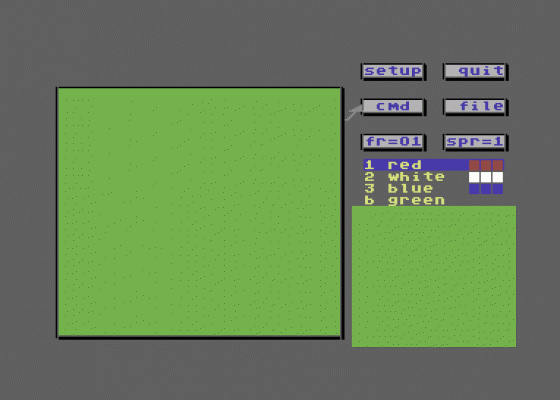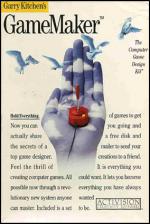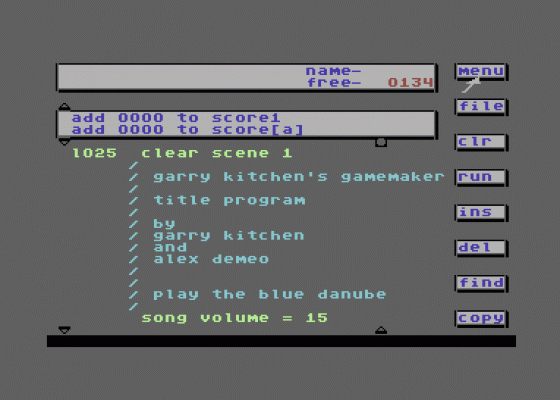
Zzap
 1st March 1986
1st March 1986
Categories: Review: Software
Publisher: Activision
Machine: Commodore 64
Published in Zzap #11
Game Maker
'Now you can create your own animated computer graphics and games just like the best professional designers with Game Maker by Garry Kitchen,' boasts the opening paragraph of the manual supplied with the program. Really? Gary Penn puts the package through its paces and comes to a conclusion...
So you want to write a game and don't know where to start? Why not try programming your fast action shoot-'em-up in BASIC? No? A compiler would speed things up wouldn't it? Not much. Oh well, looks like you'll have to learn machine code...
Then again if you find the thought or programming totally repulsive, you could always use one of those games designer thingies - Mirrorsoft's Game Creator for example? Hmm. Written by David and Richard Darling (authors of many early Mastertronic classics), Games Creator was a program that enabled the user to 'build' games by means of simple 'building blocks'. In other words, the essential elements of a game, such as graphics, sound and in fact the basics of the program itself, could all be defined separately with individual utilities and brought together to give the finished product. Unfortunately while the idea was, and indeed is, quite strong, the results were on the whole, rather weak and it wasn't really possible to produce a game of any substance due to little flexibility within the system. Still it was a start.

So now where does that leave you? What about Activision's Game Maker? Although it's very much in the same vein as Mirrorsoft's Games Creator, it adopts a different, less restrictive approach. More importantly you can create standalone programs, that is programs which run independently of Game Maker. Programming knowledge isn't required, but you do have to program as such. Don't be put off though - not a single command or listing needs to be typed in. No. Game Maker has its own 'programming' language and makes full use of an unusual 'icon' system. Those of you familiar with Garry Kitchen's previous offering, The Designer's Pencil, will recognise this system and know how easy it is to use and how well it works.
Down the right side of the screen there is a list of master commands and any one can be executed by simply selecting it with the joystick and pressing the fire button. Copious programming commands are stored behind the command window in the centre of the screen grid are accessed in a similar manner. Despite the unusual nature of a majority of these commands, the language is, as a whole, relatively easy to use - mainly due to the friendly approach of the comprehensive manual, although the fact that a majority of the commands are sufficiently self-explanatory does help.
To enable you to create graphics and sound for use within your Game Maker game there are four, easy to use programs provided. The first is Scene Maker, which is used to produce detailed background Scenery. This drawing utility is one of the best I have seen and contains some superbly implemented features, such as an excellent zoom facility and the undo command. The former gives a magnified view of what you're drawing and is handy for applying fine detail, while the latter proves very useful should you make any errors. For instance, if you find you've unintentionally drawn a line straight through your otherwise perfect picture, you can rectify the situation by selecting the undo command which promptly erases the mistake, leaving your picture intact. The circle, box and line commands draw their respective shapes on screen, but if you feel confident enough you can always draw free-hand. Any outstanding artistic endeavours can be saved out to disk for recall at a later date.

Sprite Maker is a highly competent program that lets you design any sprites you might need for your game. They can be single or multi-coloured, expanded in either or both directions, overlayed or 'stuck' together and so on. There is also the facility to animate the sprite through a series of frames.
A sprite is actually drawn with a joystick on the sprite drawing board, which dominates the left hand side of the screen and shows each dot close up as you draw it. To the right of this there is the sprite positioning window, which is where the sprite you are working on is displayed along with any others you wish to attach to it. Sprite Maker has many useful editing commands and is simple to use - results can be obtained quickly with minimal fuss and saved to disk for future use.
Sound in a Game Maker program can take two forms - sound effects or music. Sound Maker is used to create any necessary noises, while Music Maker is for those with a musical bent. The former is a wonderful piece of software which takes the form of a sort of sound effects 'mixing desk'. There are lots of sliders and knobs to fiddle with and after a little experimentation some interesting results can be achieved. All the various aspects of a sound effect can be adjusted or affected, such as the waveform and its properties, and filters can he used if so desired. The great thing about Sound Maker is that you don't need to know what you're doing, so long as the end results sound good. And thankfully most of the time they do.
Finally, there's Music Maker which is used to create background or title screen music for a game. All three voices are at your disposal, along with a number of different instruments. Notes are input on a music sheet which takes up most of the screen. As the notes are entered, they are played on a representation of a keyboard at the top of the screen so you know roughly how your tune is sounding. When you're happy with your composition it can be played back in full and saved to disk if you so desire. Even those lacking in musical talent, such as myself, can achieve reasonable results with relative ease and speed.
Once all the necessary decorative elements of a game have been finalised, they can be brought together and used with your program. Supplied with the package there are some excellent examples of what can be achieved with Game Maker and a little thought. For example the Activision classics Pitfall! and Mega Mania have been faithfully reproduced, especially the former. Other demonstrations include an animated birthday greeting card, a draw poker game, a couple of animated Christmas cards and some nifty graphics displays with balls and lines.
Conclusions
As a programming tool, Game Maker isn't overly impressive and if you want to write best selling blockbusters then definitely steer well clear, since the facilities just don't exist. However, if you are after a piece of software to entertain, then Game Maker is certainly worthy of consideration. It isn't too hard to use and some pleasing and often surprising results can be obtained quite quickly. I found it more useful for drawing pictures with Scene Maker and writing demonstration programs rather than games, and would recommend it purely on that basis. The fact that simple games can also be written is an added bonus. The title Game Maker is perhaps a bit misleading, but nevertheless this is an excellent package and an enjoyable way of messing around with your Commodore's capabilities without the hassle.
Other Reviews Of Garry Kitchen's Gamemaker For The Commodore 64
Garry Kitchen's GameMaker (Activision)
A review
GameMaker (Activision)
A review by Daniel Gilbert (Commodore User)



